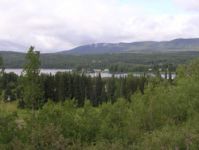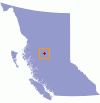
Create your own mixed adventures that suit a variety of skill levels. There are plenty of hiking trails which are also great for horseback riding and the perfect adventure route for cross-country skiing or snowmobiling.
Tweedsmuir Park allows camping, hiking, boating, angling, horseback riding and hunting (guides). Visitors should be prepared for possible encounters with large animals who are residents of the forest; mountain goats, mule deer, moose, bear and wolves. The parks lakes and rivers are surrounded by white spruce, Englemann Fir and Lodgepole pines. Fish species in the park include; mountain whitefish, rainbow trout, kokanee and burbot.
When a day of rewarding on the lake comes to an end, the village of Burns Lake finds many visitors or locals enjoying a toast to a great catch in one of its other famous watering holes.
For more entertainment off the water look to take in one of the Performing Arts and Alternative Arts Festivals held throughout the year.
Bevölkerung: 2,762
Besonderheiten:
Lakes District Museum
Lakes District Festival of the Performing Arts - April, performers from all over British Columbia
Burns Lake Bluegrass and Western Swing Music Festival, - July (first weekend)
Pinkut Creek spawning Channel & Fulton River Spawning Channel - largest salmon run in the world, August - September
Uncha Lake
Francois Lake
Babine Lake - longest natural lake in British Columbia, 177 kilometres - cliff side markings of First Nations' petroglyphs
Tweedsmuir Park - 981,000 hectares, Dean River
Bucket of Blood - old log tavern, historic trading post
Eagle Creek Deposits - agates and opals, rockhounding
Forestry self-guided tour
Heritage Walking Tour
Decker Lake
The Native Art Gallery
Nourse Creek Falls
Nadina Fisheries
Tintagel Cairn
Was man mitbringen sollte:
Angling regulations - often lakes are closed due to stock concerns, or do not open up until May. Ice may be hazardous in late March. Check with the information centre upon arrival for more details.
Geschichte:
The northern region of Burns Lake, though a village today, was inhabited over centuries by various First Nations which include; the Wet'suwet'en First Nation and the Lake Babine Nation, along with the Cheslatta Band, Burns Lake band, Skin Tyee band and Ne Yy Bunn band. These aboriginal people, today, still make up an equal population, in numbers to those of European descent.
During the discovery and development of British Columbia in its early settlement years by white Europeans in the north of the province, legend says a fire started in the region (of Burns Lake District) left trees and land sooty and black. By the time the Borland Expedition arrived, in 1866, to provide a Overland Telegraph, the area was in dark condition and was given the name Burnt Lake, later shortened to Burns Lake. There are no other speculations around the naming of the lake and town.
As the progress for the Grand Trunk Pacific Railway saw its way through the north, a large tent town was formed around 1911 that then brought many settlers including Scandinavians who would later become a major contributor to the towns cross-country / skiing expeditions. Additional settlers also created supply stores, trading posts, and sawmills - forestry / logging would be its survival industry.
Klima:
Summer average 15 degrees Celsius
Winter average 0 degrees Celsius
Area covers two biogeoclimatic subzones - one dry cool Sub-boreal Spruce and the moist-cold Engelmann Spruce-subalpine Fir.
Burns Lake Unterkünfte
Burns Lake Things to Do
British Columbia

